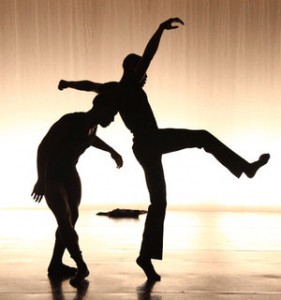Monday, December 5, 2011
By Merilyn Jackson
FOR THE INQUIRER
“Ties that Bind,” seen at the Painted Bride over the weekend, exemplified, through the choreography of three Philadelphia dance makers, just how this dance community creatively pools its resources.
The first two works, by Jennifer Morley and Olive Prince, employed rigging hanging from the fly and told stories, while Nora Gibson’s was strictly abstract floor work.
Morley presented Bearing Fruit, a poetic and mythic narrative. Ellie Goudie-Averil and another dancer, wrapped like chrysalises in hammocks, unwound themselves to join the others, including Beau Hancock, the man born of a peapod in this story. Though it works as dance theater, the choreography was so quietly basic it could not have held the attention without the storyline.
In Prince’s Under Desire, the choreography was often gratifyingly surprising, but I could not find a link between her intention to portray what people feel compelled to do before they turn 87 (as she stated in the program notes) and the actual dancing. Morley, Prince, Elizabeth Reynolds, Caitlin Hellerer and Jennifer Rose all looked Olympian in Heidi Barr’s creamy tunics and danced like goddesses too, especially Rose and Prince. I could not guess what the extended use of the fog machine could have meant, except perhaps as a dreamlike device.
If I had seen these two dances on a program by themselves, they might have compared more favorably, as they were good efforts. They were just not strong enough — choreographically in the first case, and in the second, in achieving intention — when up against Gibson’s innovative choreography and vividly met intent.
As did her 2010 Vested Souls, Gibson’s Trinity — Phase II took my breath away, this time from its first step to its final genuflection. Gibson uses clean, sharp minimalist ballet positions in a pedestrian manner, that is, she and her dancers, Jessica Warchal-King and Eiren Shuman in soft ballet slippers, sharply walk us through them. The formal preparations for a movement phrase are often strictly reversed; there is very little bent-knee work, except as preparation. Front-dipping penché arabesques spin away in the opposite direction. Certain choreographies, for ineffable reasons, remind me of Lucinda Childs, in whose work Gibson was pinpoint perfect a month ago at the Performance Garage. Gibson achieves a severely focused intellectual beauty with her chest out-shoulders down-chin forward perfect form.
Mikronesia’s Michael Reiley McDermott played his often arpeggiated electronic score live onstage.


